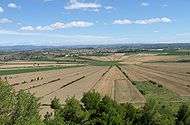Étang de Montady
The Étang de Montady, the "pond of Montady", is a drained "lagoon" [1] or more accurately a former freshwater wetland that is popularly said to have been "constructed by the Visigoths" [2] but was realised by monks during the second half of the 13th century, under authorization of the archbishop of Narbonne.[3] The Étang de Montady is near Colombiers, midway between Béziers and Narbonne, in the western department of Hérault, in southern France.
 Étang de Montady 43°19′12″N 3°07′24″E
Étang de Montady 43°19′12″N 3°07′24″E
The area was drained by making radial ditches from a single center point out to the extremities. The water flows to this center point and is then drained through an underground culvert and through the Malpas hill and under the Malpas Tunnel of the Canal du Midi.[2] The field plots are of a triangular configuration due to the radial lines from the center.
The fact that the drain for Montady went through Malpas encouraged Pierre-Paul Riquet, the designer of the Canal du Midi, that he could build a tunnel through the same hill for his canal.[2]
The Montady farming area can be seen from the Oppidum d'Ensérune.
References
- Kießler, Bernd-Wilfried (2009). The Canal du Midi: A Cruiser's Guide. Adlard Coles Nautical. p. 89. ISBN 978-1-4081-1273-1.
- Mukerji, Chandra (2009). Impossible Engineering: Technology and Territoriality on the Canal du Midi. Princeton University Press. pp. 164, 165, 198. ISBN 978-0-691-14032-2.
- P. Carrière, "Le dessèchement et l'aménagement hydraulique de l'étang de Montady (Hérault), Société Languedocienne de Géographie. Bulletin 14.2/3 (1980:199-229); this is the primary modern study; see also Hubert de Gallet Santerre, Ensérune (Paris, 1968:31).